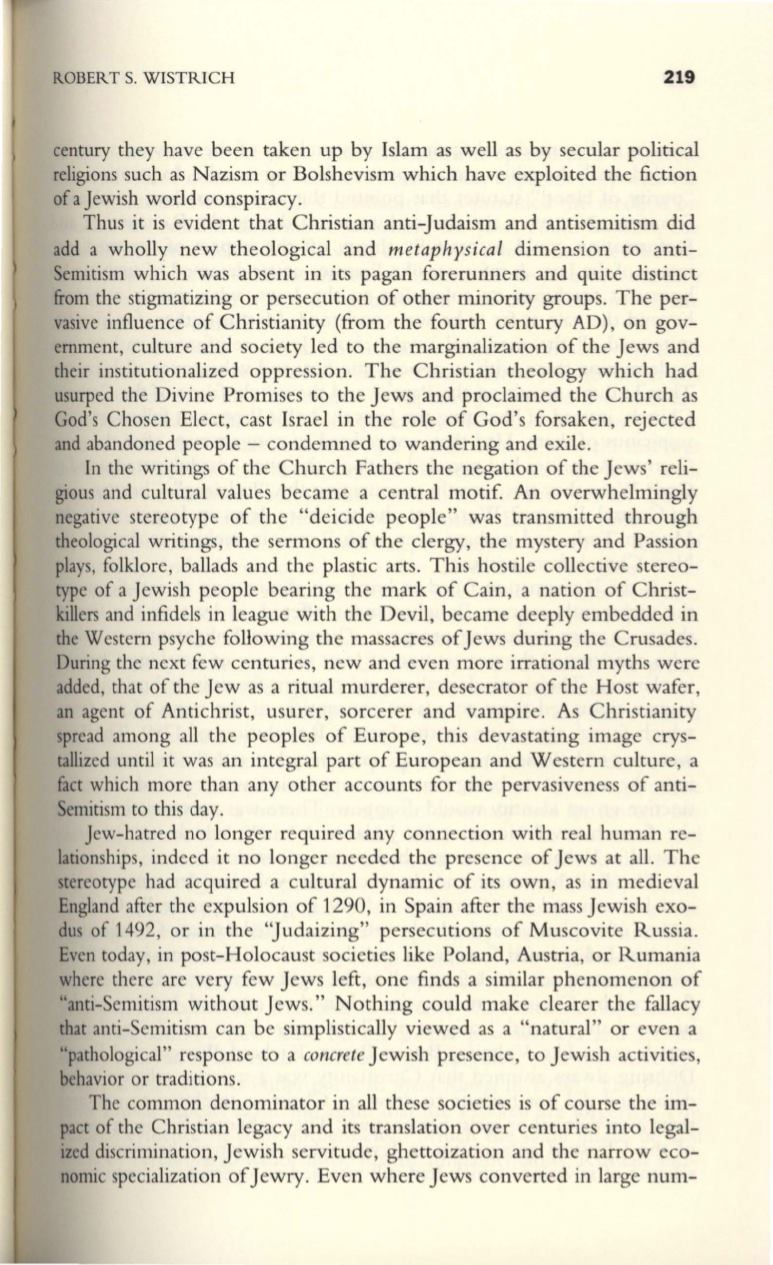
ROBERT S. WISTRICH
219
century they have been taken up by Islam as well as by secular political
religions such as Nazism or Bolshevism which have exploited the fiction
of a Jewish world conspiracy.
Thus it is evident that Christian anti-Judaism and antisemitism did
add a wholly new theological and
metaphysical
dimension to anti–
Semitism which was absent in its pagan forerunners and quite distinct
from the stigmatizing or persecution of other minority groups. The per–
vasive influence of Christianity (from the fourth century AD), on gov–
ernment, culture and society led to the marginalization of the Jews and
their institutionalized oppression. The Christian theology which had
usurped the Divine Promises to the Jews and proclaimed the Church as
God's Chosen Elect, cast Israel in the role of God's forsaken, rejected
and abandoned people - condemned to wandering and exile.
In the writings of the Church Fathers the negation of the Jews' reli–
gious and cultural values became a central motif. An overwhelmingly
negative stereotype of the "deicide people" was transmitted through
theological writings, the sermons of the clergy, the mystery and Passion
plays, folklore, ballads and the plastic arts. This hostile collective stereo–
type of a Jewish people bearing the mark of Cain, a nation of Christ–
killers and infidels in league with the Devil, became deeply embedded in
the Western psyche following the massacres ofJews during the Crusades.
During the next few centuries, new and even more irrational myths were
added, that of the Jew as a ritual murderer, desecrator of the Host wafer,
an agent of Antichrist, usurer, sorcerer and vampire. As Christianity
spread among all the peoples of Europe, this devastating image crys–
tallized until it was an integral part of European and Western culture, a
fact which more than any other accounts for the pervasiveness of anti–
Semitism to this day.
Jew-hatred no longer required any connection with real human re–
lationships, indeed it no longer needed the presence of Jews at all. The
stereotype had acquired a cultural dynamic of its own, as in medieval
England after the expulsion of 1290, in Spain after the mass Jewish exo–
dus of 1492, or in the "Judaizing" persecutions of Muscovite Russia.
Even today, in post-Holocaust societies like Poland, Austria, or Rumania
where there are very few Jews left, one finds a similar phenomenon of
"anti-Semitism without Jews." Nothing could make clearer the fallacy
that anti-Semitism can be simplistically viewed as a "natural" or even a
"pathological" response to a
concrete
Jewish presence, to Jewish activities,
behavior or traditions.
The common denominator in all these societies is of course the im–
pact of the Christian legacy and its translation over centuries into legal–
ized discrimination, Jewish servitude, ghettoization and the narrow eco–
nomic specialization ofJewry. Even where Jews converted in large num-


